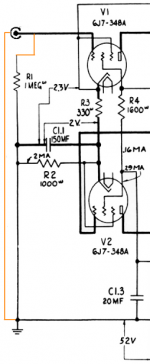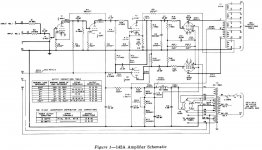Presumably to damp the primary windings. (Stability and to improve square wave response?)
I agree. The leakage inductance of the OPT windings will raise the impedance seen by the tubes, increasing their gain and thus reducing the stability margin of the feedback loop. The RC functions as a sort of Zobel to cancel the OPT reflected load resistance plus leakage inductance. Since the transformer is not perfectly symmetrical, the pot allows optimization of high frequency performance.
My story would sound better if I had any idea what performance was being optimized! Probably a service manual would give a clue, if one still exists.
The dual feedback loops to the cathode and screen grid(!) of the input tube are very unusual.
I also have a question about the OPT impedance. Several places have said the 171-C is 10K. Doesn't this seem high for PP 6L6? They typically are in the 4K to 6K range. I realize the 124 is not trying to maximize output. It only outputs 12W at the lower B+ setting. Thoughts?
Luke, I too am interested in building an amp based on the WE 124 design. Someone in this thread mentioned an article somewhere from a guy who built one on a Heath chassis and tried different OPTs (including the WE 171C). He concluded that the magic in the 124 amp is actually in its circuit design and not the iron used. He compared his amp to an actual WE 124 and found that he was able to surpass the original in sound quality using a different vintage OPT and some other updated parts. Unfortunately, the site where that article appeared has been closed but I have a copy of it in my files. If you want to read it, I can look for it and send it to you.
All I know from firsthand experience is that a pair of true 124 amps can sound absolutely wonderful. There is a store not too far from me that specializes in vintage gear and I have heard the owner's pair several times on various speakers. Not quite the same as hearing them in my own home, I admit, but what I heard in his store was very nice indeed. Also, his 124s have WE 350B outputs which are supposed to be pretty special as well.
Hi Thanks for this info. I would love to read the article if you could find it. My email is: Pompeipaints@gmail.com
I thought that OPT meant output transformer> Is the 171c an input transformer or output? I thought it was an input type. I was thing about getting a vintage NON- W.E. input trans. that matched the specs of the 171. I understand that you do not need an input transformer to run these. I do not understand how the amp could run with or without the transformer input. I know the transformer input changes the impedance but that is the little i know. I plan on using a hammond transformer for the power supply and for the output. I have some beautiful old MUllard EL37 (Similar to 6L6) tubes that I want to use for this project. How far along are you on your 124 project? Do you know anything about the difference between the 124 and the 142 amplifiers? I am excited about beginning soon. I need to keep researching to figure out exactly how to do this project. Thanks for your reply.
The article I recalled is the one at the link in Post #9 above.
The output transformer used in the 124 amps (as well as some other WE amps) is the 171-C.
My plan for the 124 is to wire it into a pair of DIY monoblocks I built a few years ago. I will probably use Hammond 1650R output transformers since that's what are in the amps already. The 1650R is 5K which has worked fine with 6L6GC, Kt77, KT 88 and KT120 all in fixed bias.
The output transformer used in the 124 amps (as well as some other WE amps) is the 171-C.
My plan for the 124 is to wire it into a pair of DIY monoblocks I built a few years ago. I will probably use Hammond 1650R output transformers since that's what are in the amps already. The 1650R is 5K which has worked fine with 6L6GC, Kt77, KT 88 and KT120 all in fixed bias.
OK I have just read the article about 124 amps that is linked above. It is giving me some hope for a decent outcome. I have two questions after reading this link .
1. "Very Important" - Buck the line voltage with a 6.3v filament transformer
What does this "buck the line voltage" mean?
2. Can anyone tell me of a couple different vintage output transformers that might be comparable to the W.E. 171 C? I am interested in trying a vintage Transformer but don't want to spend the huge money for Western Electric.
3. I am still unclear about the input transformers. Are these an important part of the sound? Should I not even worry about that arrangement?
THANKS FOR ALL OF YOUR HELP. LUKE
1. "Very Important" - Buck the line voltage with a 6.3v filament transformer
What does this "buck the line voltage" mean?
2. Can anyone tell me of a couple different vintage output transformers that might be comparable to the W.E. 171 C? I am interested in trying a vintage Transformer but don't want to spend the huge money for Western Electric.
3. I am still unclear about the input transformers. Are these an important part of the sound? Should I not even worry about that arrangement?
THANKS FOR ALL OF YOUR HELP. LUKE
. . . Do you know anything about the difference between the 124 and the 142 amplifiers?
Here's a copy of the WE142 schematic. It's also a 6L6 push-pull amplifier but the circuit design is more conventional.
---Gary
Attachments
You might want to talk to Jack Elliano at Electra-Print, he can make a set of output transformers with 10K PP primary impedance and a single or multiple secondaries as you prefer. I have used his output transformers in a couple of my projects and am very pleased with their performance.
He is not too expensive, and you could spend much more and end up with something not appreciably better.
Other possible options on the vintage front would be UTC, Chicago, Acrosound, etc..
FWIW, IMHO the 124 is a much more interesting circuit than the apparently later 142...
He is not too expensive, and you could spend much more and end up with something not appreciably better.
Other possible options on the vintage front would be UTC, Chicago, Acrosound, etc..
FWIW, IMHO the 124 is a much more interesting circuit than the apparently later 142...
shouldn't R1 go to the V1 input & the input ground connection go to the circuit ground?
You are, of course, correct! Sorry, innocent mistake. Here's the repost of schematic:
An externally hosted image should be here but it was not working when we last tested it.
The other circuit that's similar to the 124 is the earlier model 118A that is 6L6 parallel push pull and it uses two 6J7's as driver circuit but it uses the 618C input transformer as phase splitter. It's a lot more symmetrical and to me more appealing. Never heard its sound so I can't compare. What's curious is that one pair of 6L6's don't have grid stoppers.

An externally hosted image should be here but it was not working when we last tested it.
Does anyone know the primary impedance of the 171c Western Electric output transformer?
Take a look at here:
http://www225.pair.com/audio/waltzingbear/Schematics/Western_Electric/WE_Transformers_1964.pdf
You should find all the data that you're looking for there.
---Gary
Another interesting WE amp is the 133 which also uses a pair of 6J7/348A drivers but with 349A outputs. It has similar feedback from the plates of the output tubes back to the cathodes and screens of the the input/drivers, but in the 133 the feedback loops are symmetrical. The 133 uses the input transformer for phase splitting instead of the 124's floating paraphase.
Does anyone know the primary impedance of the 171c Western Electric output transformer?
Thanks to GaryB's info, it is 10k primary.
An externally hosted image should be here but it was not working when we last tested it.
It's nice to have confirmation of the 10K but it still leaves the question why is it so high? The typical rating for 6L6 PP amps today is 4K to 6K.
Maybe not having OPT inside the feedback loop has something to do with it? Others will chime in, I'm sure. You lose some power but have lower distortion and easier load for the output tubes. I don't see 10K being so high.
Take a look at here:
http://www225.pair.com/audio/waltzingbear/Schematics/Western_Electric/WE_Transformers_1964.pdf
You should find all the data that you're looking for there.
---Gary
Thanks Gary, This is helpful. I am learning a lot from this discussion.
You might want to talk to Jack Elliano at Electra-Print, he can make a set of output transformers with 10K PP primary impedance and a single or multiple secondaries as you prefer. I have used his output transformers in a couple of my projects and am very pleased with their performance.
He is not too expensive, and you could spend much more and end up with something not appreciably better.
Other possible options on the vintage front would be UTC, Chicago, Acrosound, etc..
FWIW, IMHO the 124 is a much more interesting circuit than the apparently later 142...
Hi- Thanks for this info......I was considering using the Hammond out puts, I have had good luck with those. Are the transformers from Electa- Print a higher quality product? I am going to contact him to get a price.
For interest,
http://images.tubebbs.com/clone/we-amp/No.124-A.pdf
And
Vintage hifi experience: Western Electric 124 - Finally got it!
The only You tube link appears to be this../ not much use but interesting..
Western electric 124 amplifier - YouTube
Regards
M. Gregg
Thanks M. Gregg....I have seen the You Tube clip years ago and it is great......in the other link it is neat to think that a guy could "select" a pair of 124 amps from a "wall of 124 Amps" in order to match a pair. Those days must be over by now. He must have been very excited to listen to those things.
- Status
- This old topic is closed. If you want to reopen this topic, contact a moderator using the "Report Post" button.
- Home
- Amplifiers
- Tubes / Valves
- Western Electric 124 amplifier

